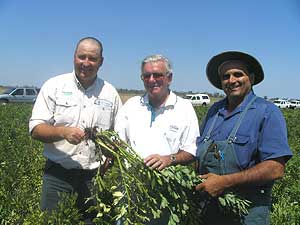Dalby, Queensland
October 26, 2004
|
Grains industry advisers
were interested enough in the potential of faba beans on
the heavier soils of the Darling Downs to turn up in
numbers to a field day outside Dalby earlier this month.
Growers Chris Joseph and
Peter Stephen had planted 12 irrigated hectares to the
new faba bean variety Cairo, selected for its specific
adaptation to the northern grains region by New South
Wales Department of Primary Industries breeder Ian Rose
in the national faba bean breeding program supported by
the Grains Research and
Development Corporation (GRDC) and the Australian
Government .
Advisers and interested farmers were invited to Oakleigh
Park, east of Dalby, to inspect the crop and discuss it
with Goondiwindi agronomist Paul Castor, who has had 15
years experience with faba beans, and Dalby Landmark
agronomist David Hall, who managed the Joseph/Stephen
crop.
Queensland Department of Primary Industries and
Fisheries pulse agronomist Mike Lucy and pathologist
Mike Fuhlbohm also took part in discussions, along with
Pulse Australia manager of crop support, John Slatter. |
 |
|
Going
for Cairo (from left) Todd Jones, northern NSW manager
for PlantTech, Pulse Australia manager of crop support,
John Slatter, and GRDC northern panel member Chris
Joseph |
Mr Slatter said the release of
Cairo and the new northern field pea Yarrum released by Sunprime
Seeds provided a source of pulses better suited to the range of
soil types in southern Queensland and northern NSW. Almost 100
farmers had obtained Cairo seed and planted it in the 2004
winter season
"Market wise, a well harvested sample of Cairo faba bean will be
at least equal to the variety Fiesta as exported out of
Adelaide, and that is the quality buyers like Egypt want," Mr
Slatter said.
"Cairo is likely to bring a $50 a tonne premium over Barkool or
Fiesta and, as of now, we need to start getting those varieties
out of the system before we find a problem in the market place.
"While we plan accredited faba and field pea courses in the new
year, today is a magic opportunity for agronomists to obtain
some understanding of faba beans as a crop, so they can better
assist those farmers who decide to try Cairo next year."
Mr Castor said the question was how well adapted faba beans were
to Queensland environments. The crop was susceptible to frost,
particularly during flowering and podding, and very sensitive to
hot, dry, finishing conditions. Hopefully, new varieties would
have improved adaptation to the region
Faba beans certainly were an attractive alternative to chickpeas
and a good winter break crop, particularly on flatter, heavier,
wetter soils where chickpeas were at risk of being affected by
waterlogging and phytopthora root rot,
In the Goondiwindi district they were mostly grown on heavy
soils around Boomi and Caloona, in New South Wales.
Faba beans delivered more benefits to a following crop than
chickpea, fixing more nitrogen and providing a better break for
stubble borne disease such as crown rot, because of the improved
residue breakdown under their heavier crop canopy.
They conflicted less with general farm operations, being planted
and harvested before wheat. With their early finish they usually
left more soil moisture behind them than chickpea, another
factor favourable to a following crop.
"Faba beans do suit moisture seeking, because they will emerge
strongly from depth, but strong early plant development is
crucial," Mr Castor said.
"In the Goondiwindi district this is generally provided by
planting into good moisture from late April to mid May, but
excessive vegetative growth can result in problems with lodging
and poor conversion of growth to grain yield.
"Planting dates between May 10 and 15 appear to be a good
compromise but will need to be further developed for new
production areas. Later plantings can limit yield potential by
pushing the vegetative period into a cold frosty period and
grain filling into a hot dry period." |